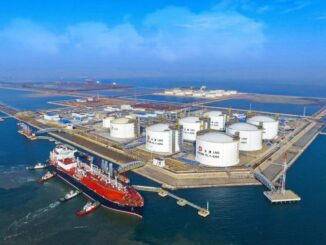
Speculative funds have continued to move towards the short side of crude oil markets, analysts at Standard Chartered noted in a new report sent to Rigzone this week.
“Money-manager shorts across the four main Brent and WTI contracts rose week on week by 31.7 million barrels to 209.5 million barrels in the latest positioning data, while money-manager longs fell by 16.0 million barrels to 456.4 million barrels,” the analysts stated in the report.
“According to our money-managing positioning indices, only palladium among the main metals and energy contracts is less preferred by money managers than crude oil as a long exposure,” they added.
The reduction in the crude oil net long over the past six weeks has been 258.3 million barrels, the analysts highlighted in the report. They pointed out that this is the largest six-week move of money-manager funds to the short side since early March 2020 “at the start of the pandemic”.
“Long-short ratio indicators tell a similar story, with the ratio in the Chicago Mercantile Exchange (CME) WTI contract falling to 2.0 in the latest data, a sharp fall from 11.4 six weeks ago,” the analysts said in the report.
“The main theme that emerges among money managers as their motivation for such a large move to the short side is a fear of future extreme demand weakness,” they added.
“We think the dynamic behind current speculative flows is a reoccurrence of the macro-led concerns – about the U.S. and China economies in particular – that temporarily took Brent below $72 per barrel in May this year,” they continued.
“Speculative net selling was a little slower in May (the six-week rate peaked at 231.6 million barrels, 10 percent less than over the past six weeks). However, the narrative among speculative traders of weakening demand conditions seems very similar,” they went on to state.
In the report, the analysts noted that a few supply strands have attached themselves to the main demand weakness concerns.
“However, most of them seem to be confusion about seasonality and the relationship between exports and production,” they said in the report.
“For example, with demand for air conditioning in the Middle East lower now that the northern hemisphere summer is over, oil use in power generation is lower, which has freed up quantities for export,” they added.
“That increase in export availability is pure seasonality; yet it has been pointed to in some recent analysis, incorrectly in our view, as indicative of higher supply and a loss of producer discipline,” they said.
The scale of the current speculative move in oil is not justified by fundamental data, the Standard Chartered analysts stated in the report.
“We noted the key role of India’s oil demand growth in an earlier report and the latest monthly data from the Government of India Petroleum Planning and Analysis Cell (PPAC) was strong,” they said.
“India’s oil demand rose year on year by 211,000 barrels per day in October to 5.004 million barrels per day. Diesel demand was particularly strong, rising 9.3 percent year on year to 1.88 million barrels per day, while gasoline demand rose 4.8 percent year on year to 861,000 barrels per day,” they added.
“Our supply and demand model shows global demand rising 2.02 million barrels per day year on year in October and we forecast demand growth will stay above 1.5 million barrels per day in November, December, and January, with our forecast for 2024 growth at 1.5 million barrels per day,” they continued.
The analysts outlined in the report that, in their view, the latest monthly reports from the main oil balance agencies “also lend little support to the speculative-led plunge in prices”.
“Forecasts for 2024 demand growth were little changed; the International Energy Agency (IEA) forecast increased 50,000 barrels per day to 930,000 barrels per day, the OPEC Secretariat forecast was unchanged at 2.246 million barrels per day and the Energy Information Administration (EIA) forecast increased 81,000 barrels per day to 1.393 million barrels per day,” they noted in the report.
“All three agencies increased their 2023 and 2024 forecasts of absolute oil demand in both years, and all increased their Q4-2024 demand forecast,” they added.
“The only split came in views of demand in Q3-2023, with respective increases of 330,000 barrels per day and 201,000 barrels per day in the EIA and EIA estimates, but a decrease of 64,000 barrels per day in the OPEC Secretariat estimate,” the analysts continued.
The Standard Chartered analysts stated in the report that the extreme demand pessimism the oil market showed in May proved to be unfounded and added that the “speculative led undershoot in prices provided the base for a rally that extended to over $25 per barrel before the macro-led gloom descended again”.
“We think the current price weakness is also a significant undershoot,” they said in the report.
“The scale of speculative selling, the collapse in the long-short ratio, and the media and trader concentration on supposed demand weakness are the same now as in May, and we think the price rebound is likely to be similar,” they added.
In the report, Standard Chartered projects that, in the first quarter of 2024, the ICE Brent price will average $92 per barrel and the NYMEX WTI price will average $89 per barrel. Overall in 2024, the company expects the ICE Brent price to average $98 per barrel and the NYMEX WTI price to average $95 per barrel.
In a report sent to Rigzone on September 26, Standard Chartered projected that the ICE Brent price would average $93 per barrel and the NYMEX WTI price would average $91 per barrel in the fourth quarter. In that report, the company anticipated that the former would come in at $91 per barrel and that the latter would average $88 per barrel overall in 2023.
The U.S. Energy Information Administration’s (EIA) latest short term energy outlook (STEO), which was released earlier this month, forecast that the Brent spot price will average $90.27 per barrel in the fourth quarter of this year and $83.99 per barrel overall in 2023. The EIA projected in the November STEO that the WTI spot price will average $85.93 per barrel in the fourth quarter and $79.41 per barrel overall in 2023.
The EIA expects the Brent average spot price to come in at $93.24 per barrel and the WTI spot price to average $89.24 per barrel overall in 2024, the November STEO shows.
In a report sent to Rigzone last week, analysts at Standard Chartered noted that they expect oil demand growth to slow in China in 2024 and speed up in India.
“We expect China’s oil product demand growth will slow to 516,000 barrels per day in 2024 from 819,000 barrels per day in 2023, the result of a fall in GDP growth to 4.8 percent in 2024 (from 5.4 percent to 2023) and some unfavorable base effects in key sectors including petrochemicals (following very favorable base effects in 2023),” the analysts stated in that report.
“We forecast India’s demand growth will increase to 331,000 barrels per day in 2024 from 268,000 barrels per day in 2023, helped by favorable base effects and only a slight slowing in GDP growth (6.0 percent in 2024 from 6.1 percent in 2023),” they added.
The Asia-Pacific region accounts for 79 percent of global oil demand growth over the past 10 years, the Standard Chartered analysts revealed in the report, adding that “China alone accounts for 58 percent and India a further 18 percent over this period”.
ENB Top News
ENB
Energy Dashboard
ENB Podcast
ENB Substack



